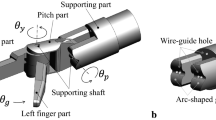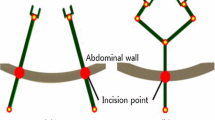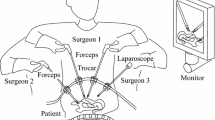Abstract
For precision enhancement, many robotic systems for minimally invasive surgery (MIS) have been developed. However, a positioning arm that firmly fixes the initial position of surgical robot arm has not been researched in depth yet. Since a positioning arm is a device for positioning a surgical robots, it should be equipped with a robust locking mechanism against external force. Furthermore, as repositioning of the surgical robot occurs frequently before and during the operation, the positioning arm needs a mechanism to lock and unlock multi-degrees-of-freedom (MDoF) simultaneously to reduce the setup time. Therefore, we propose a novel MDoF locking mechanism applicable to a positioning arm for MIS. When the knob of the locking mechanism is rotated, the two joints are locked simultaneously by the movement of the friction pad and the locking block that is mounted inside the positioning arm. Considering the locking time and the locking torque, the design parameters of the locking mechanism were determined to be optimal. The proposed locking mechanism was implemented and verified on a positioning arm for MIS. The first experimental results showed that only the negligible clearance between the joints was generated during the locking and unlocking transition. These indicate that positioning of the surgical robot is precise when the proposed mechanism is applied. The second experimental results showed that the proposed locking mechanism has a higher performance than the conventional locking device, in terms of locking torque. These indicate that the proposed locking mechanism will enhance safety in a surgical environment.












Similar content being viewed by others
References
Guthart, G. & Salisbury, J. (2000). The intuitive telesurgery system: Overview and application. In Proceedings of the 2000 IEEE international conference on robotics and automatic (pp. 618-621).
Lum, M. J. H., et al. (2009). The RAVEN: Design and validation of a telesurgery system. The International Journal of Robotics Research, 28(9), 1183–1197.
Konietschke, R., et al. (2009). The DLR MiroSurge-A robotic system for surgery. Gurgaon: ICRA.
Tadano, K., et al. (2010). Development of a pneumatic surgical manipulator IBIS IV. Journal of Robotics and Mechatronics, 22(2), 179.
Hwang, M., Yang, U.-J., Kong, D., Chung, D. G., Lim, J-g, Lee, D.-H., et al. (2017). A single port surgical robot system with novel elbow joint mechanism for high force transmission. The International Journal of Medical Robotics and Computer Assisted Surgery.
Pouya, I., et al. (2010). Set up and docking of the da Vinci®surgical system: prospective analysis of initial experience. The International Journal of Medical Robotics and Computer Assisted Surgery, 6(1), 57–60.
Faraz, A., & Payandeh, S. (1998). A robotic case study: Optimal design for laparoscopic positioning stands. The International Journal of Robotics Research, 17(9), 986–995.
Plooij, M., et al. (2015). Lock your robot: A review of locking devices in robotics. IEEE Robotics & Automation Magazine, 22(1), 106–117.
Palpacelli, M., Carbonari, L., & Palmieri, G. (2014). A lockable spherical joint for robotic applications. In Proceedings of the IEEE/ASME 10th International Conference on Mechatronic Embedded Systems Applications (pp. 1–6).
Parrott, C., Dodd, T., & Gross, R. (2014). HiGen: A high-speed genderless mechanical connection mechanism with single-sided disconnect for selfreconfigurable modular robots. In Proceedings of the IEEE/RSJ international conference on intelligent robots systems (pp. 3926–3932).
Brackx, B., van Damme, M., Matthys, A., Vanderborght, B., & Lefeber, D. (2013). Passive ankle-foot prosthesis prototype with extended push-off. International Journal of Advanced Robotic Systems, 10(101), 1–9.
Cherelle, P., Grosu, V., Matthys, A., Vanderborght, B., & Lefeber, D. (2014). Design and validation of the ankle mimicking prosthetic foot 2.0. IEEE Transactions on Neural Systems and Rehabilitation Engineering, 22(1), 138–148.
Ajoudani, A., Gabiccini, M., Tsagarakis, N. & Bicchi, A. (2013). Human-like impedance and minimum effort control for natural and efficient manipulation. In Proceedings of the IEEE international conference on robotics automation (pp. 4499–4505).
van Oort, G., Carloni, R., Borgerink, D. J., & Stramigioli, S. (2011). An energy efficient knee locking mechanism for a dynamically walking robot. In Proceedings of the IEEE international conference on robotics and automation (pp. 2003–2008).
Bica, I. (2004). Magnetorheological suspension electromagnetic brake. Journal of Magnetism and Magnetic Materials, 270(3), 321–326.
Li, R., et al. (2006). Investigation of power supplies for a piezoelectric brake actuator in aircrafts. In 2006 CES/IEEE 5th international power electronics and motion control conference (Vol. 2) IEEE.
Yamatoh, K., Ogura, M., Kanbe, K., & Isogai, Y. (1989). Piezoelectric brake device. U.S. Patent 4 854 424.
Mercorelli, P., & Werner, N. (2016). Integrating a piezoelectric actuator with mechanical and hydraulic devices to control camless engines. Mechanical Systems and Signal Processing, 78, 55–70.
Mironova, A., Mercorelli, P., & Zedler, A. (2016). Robust control using sliding mode approach for ice-clamping device activated by thermoelectric coolers. IFAC-PapersOnLine, 49(25), 470–475.
Mironova, A., Mercorelli, P., & Zedler, A. (2018). A multi input sliding mode control for peltier cells using a cold-hot sliding surface. Journal of the Franklin Institute, 355(18), 9351–9373.
Shamaei, K., Napolitano, P., & Dollar, A. (2014). Design and functional evaluation of a quasi-passive compliant stance control knee-ankle-foot orthosis. IEEE Transactions on Neural Systems and Rehabilitation Engineering, 22(2), 258–268.
Tsagarakis, N., Morfey, S., Dallali, H., Medrano-Cerda, G. & Caldwell D. (2013). An asymmetric compliant antagonistic joint design for high performance mobility. In Proceedings of the IEEE/RSJ international conference intelligent robots systems (pp. 5512–5517).
Peerdeman, B., Stramigioli, S., Hekman, E. E., Brouwer, D. M., & Misra, S. (2013). Development of underactuated prosthetic fingers with joint locking and electromyographic control. Mechanical Engineering Research, 3(1), 130.
Eitan, Y. (2017). Articulated conduit device. U.S. Patent No. 9,732,890.
Engineering ToolBox. (2004). Friction and Friction Coefficients for various Materials. [online] Available at: https://www.engineeringtoolbox.com/friction-coefficients-d_778.html.d
AMSC, N., & AREA HFAC, A. (1999). Department of defense design criteria standard. Signal 44.5.3: 4.
Acknowlwdgements
This work was supported in part by the Korea Health Technology R&D Project through the Korea Health Industry Development Institute and in part by the Ministry of Health and Welfare, Republic of Korea under Grant #HI17C2012.
Author information
Authors and Affiliations
Corresponding author
Ethics declarations
Conflict of interest
The authors declare that they have no conflict of interest
Additional information
Publisher's Note
Springer Nature remains neutral with regard to jurisdictional claims in published maps and institutional affiliations.
Rights and permissions
About this article
Cite this article
Kim, CK., Kong, D., Kim, D.S. et al. Novel Multi-Degrees-of-Freedom Friction-Based Locking Mechanism Applicable to Positioning Arm for Minimally Invasive Surgery. Int. J. Precis. Eng. Manuf. 22, 83–93 (2021). https://doi.org/10.1007/s12541-020-00412-x
Received:
Revised:
Accepted:
Published:
Issue Date:
DOI: https://doi.org/10.1007/s12541-020-00412-x




